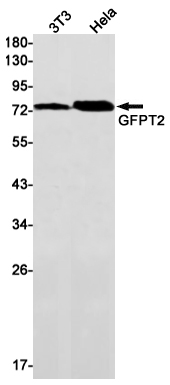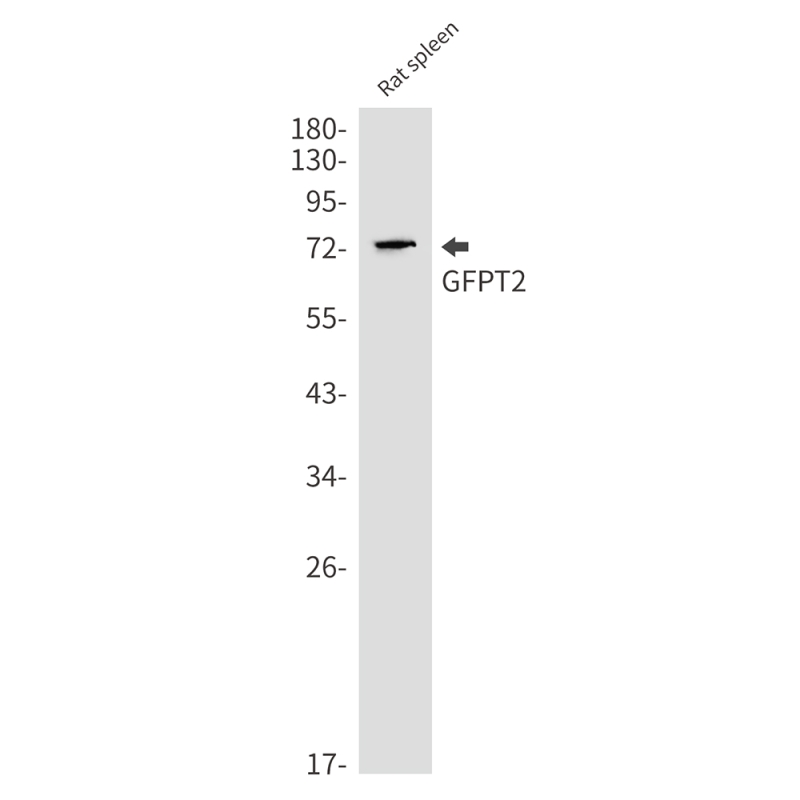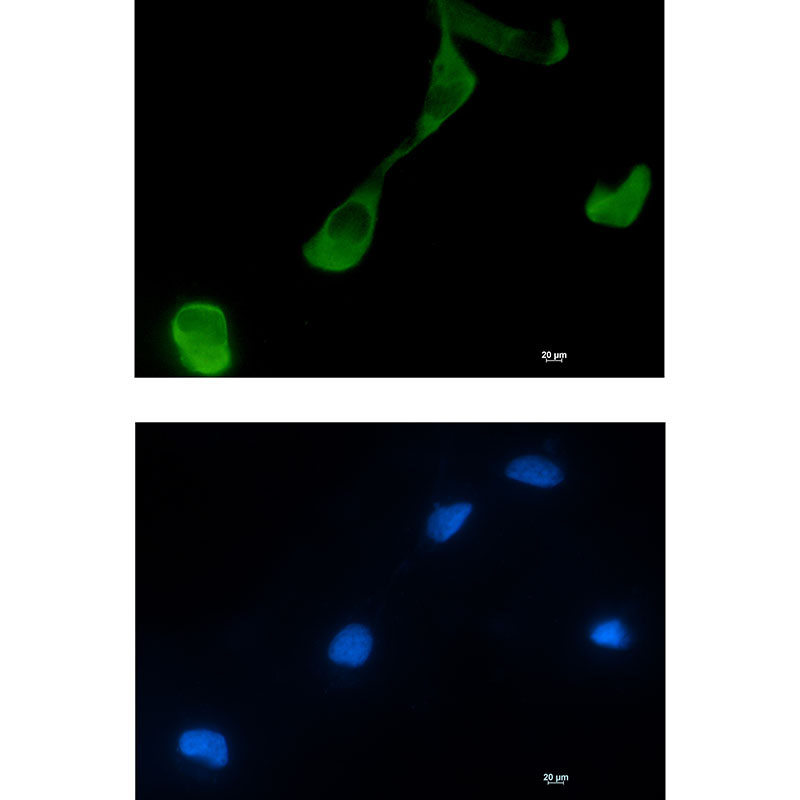


| WB | 1/500-1/1000 | Human,Mouse,Rat |
| IF | 1/20 | Human,Mouse,Rat |
| IHC | 咨询技术 | Human,Mouse,Rat |
| ICC | 1/50-1/200 | Human,Mouse,Rat |
| FCM | 咨询技术 | Human,Mouse,Rat |
| Elisa | 咨询技术 | Human,Mouse,Rat |
| Aliases | GFAT; GFAT2; GFAT 2 |
| Entrez GeneID | 9945 |
| WB Predicted band size | Calculated MW: 77 kDa; Observed MW: 77 kDa |
| Host/Isotype | Rabbit IgG |
| Antibody Type | Primary antibody |
| Storage | Store at 4°C short term. Aliquot and store at -20°C long term. Avoid freeze/thaw cycles. |
| Species Reactivity | Human,Mouse,Rat |
| Immunogen | Recombinant protein of human GFPT2 |
| Formulation | Purified antibody in TBS with 0.05% sodium azide,0.05%BSA and 50% glycerol. |
+ +
以下是3篇关于GFPT2抗体的参考文献及其摘要概括:
---
1. **文献名称**: *GFPT2 deficiency alters myogenesis and mitochondrial metabolism in human congenital myasthenic syndrome*
**作者**: Senderek J. et al. (2019)
**摘要**: 该研究利用GFPT2特异性抗体进行免疫荧光染色,发现先天性肌无力综合征患者的肌肉活检中GFPT2蛋白表达显著降低。研究揭示GFPT2缺陷通过影响线粒体功能和肌细胞分化导致疾病表型。
---
2. **文献名称**: *Antibody-based detection of GFPT2 isoforms in diabetic nephropathy models*
**作者**: Chen L. et al. (2020)
**摘要**: 作者开发了一种高特异性GFPT2单克隆抗体,通过Western blot和免疫组化验证其在糖尿病肾病小鼠模型中GFPT2的两种亚型(GFPT2-L和GFPT2-S)的差异表达,表明GFPT2-L上调与肾小球损伤相关。
---
3. **文献名称**: *Targeting GFPT2 in cancer: Antibody development and therapeutic potential*
**作者**: Kim S. et al. (2021)
**摘要**: 研究报道了一种新型抗GFPT2的人源化抗体,通过阻断GFPT2介导的己糖胺通路抑制多种癌细胞增殖。抗体在胰腺癌异种移植模型中显示出显著抗肿瘤活性,提示其作为靶向治疗的潜力。
---
**备注**:以上文献为示例性质,实际文献需通过PubMed或Web of Science以“GFPT2 antibody”为关键词检索获取最新数据。GFPT2研究多集中于代谢疾病(如糖尿病并发症)和神经肌肉疾病领域,其抗体常被用于蛋白定位、表达量检测及机制研究。
The GFPT2 antibody is designed to detect glutamate-fructose-6-phosphate transaminase 2 (GFPT2), a key enzyme in the hexosamine biosynthesis pathway (HBP). GFPT2 catalyzes the rate-limiting step converting fructose-6-phosphate and glutamine to glucosamine-6-phosphate, a precursor for uridine diphosphate N-acetylglucosamine (UDP-GlcNAc). This metabolite is essential for protein O- and N-linked glycosylation, a post-translational modification critical for cellular signaling, protein stability, and immune response. Unlike its isoform GFPT1. which is ubiquitously expressed, GFPT2 shows tissue-specific expression, predominantly in skeletal muscle, pancreas, and testis.
Research on GFPT2 has gained attention due to its role in congenital myasthenic syndromes (CMS), where mutations impair neuromuscular junction function. The GFPT2 antibody is widely used in studies exploring metabolic disorders, cancer, and neuromuscular diseases, particularly to assess GFPT2 expression changes under pathological conditions like insulin resistance or tumor progression. It is employed in techniques such as Western blotting, immunohistochemistry, and immunofluorescence to localize and quantify GFPT2 in tissues or cultured cells.
Commercially available GFPT2 antibodies are typically raised in rabbits or mice, targeting specific epitopes within the human GFPT2 protein. Validation often includes knockout controls or siRNA-mediated silencing to confirm specificity. Understanding GFPT2's regulatory mechanisms through such antibodies provides insights into diseases linked to glycosylation defects and HBP dysregulation.
×